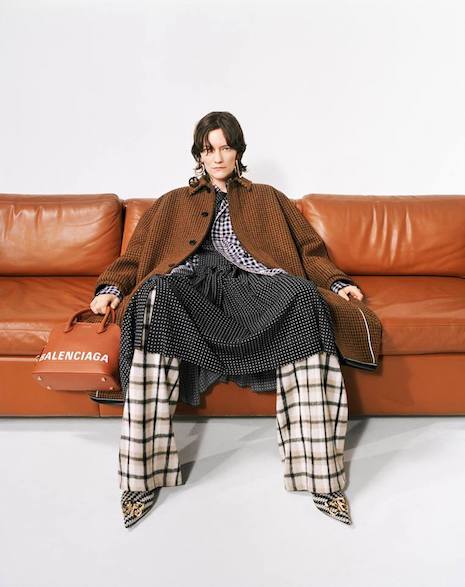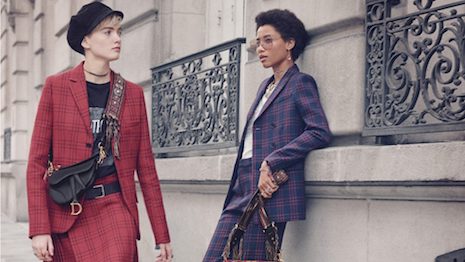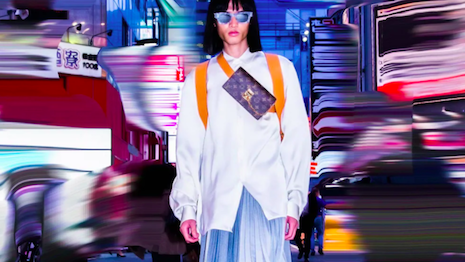As streetwear and luxury increasingly converge, secondhand seller The RealReal has seen a 56 percent increase year-over-year in menswear shoppers buying across both categories.
Gucci, Louis Vuitton and Prada are the most frequently purchased labels by streetwear shoppers, acting as an entry point into luxury for consumers who previously bought brands such as Off-White and Supreme. Streetwear on The RealReal saw a 281 percent year-over-year growth in interest, as both men and women and seek out menswear pieces from sneakers to hoodies.
"As streetwear demand rises, it's having a ripple effect across all of men's fashion," said Dominik Halás, menswear and archival expert at The RealReal, in the report.
"Luxury brands are embracing collaborations and new creative heads to broaden their appeal," he said. "It's paying off in strong luxury demand among streetwear buyers, particularly with Virgil Abloh's artistic direction for Louis Vuitton and Alessandro Michele's bold collections for Gucci."
The RealReal’s Resale Report is based on the resale retailer’s shopper data.
Stock in streewear
Gucci has retained its leading position in search volume on The RealReal. Whereas Gucci, Louis Vuitton and Chanel used to be fairly even in searches, Gucci and Louis Vuitton have accelerated past Chanel thanks to their successful courting of millennial buyers.
Also indicative of streetwear’s influence on purchasing, Balenciaga rose into the top 10 most searched brands for the first time. Under creative director Demna Gvasalia, Balenciaga has undergone a makeover that has made it one of the hottest brands in the primary luxury market (see story).

Balenciaga has seen resale growth. Image credit: Balenciaga
Consumers about doubled their searches for Balenciaga, Dior and Fendi, driven by their success at making an impression on millennials.
Celine meanwhile fell out of the top 10. The RealReal’s head of women’s Sasha Skoda attributes this to a “wait and see” approach from buyers, as the brand shifts to a new look under Hedi Slimane.
Since Celine has changed its look, the customer from Phoebe Philo’s tenure might be looking for a new brand, opening the door for female-led designers. Staud and Khaite were the emerging brands with the most searches.
As luxury brands revive classic styles, such as Dior’s Saddle bag and Fendi’s Baguette, the resale values of archival pieces has seen an uptick.

The comeback of Dior's Saddle bag in new collections has boosted prices for vintage versions. Image credit: Dior
Consumers today are considering the resale value of investment handbag purchases as they shop. The RealReal notes that while some bags such as an Hermès Birkin have a stable resale value, others are more trend-driven, with resale value declining over time.
Ms. Skoda noted it is becoming more difficult to pin down specific trends, since shoppers today are more guided by personal style, partly due to social media and a desire for self expression. Resale therefore enables consumers to buy current and past trends, playing more with their wardrobe curation.
Social media is also having an impact on the home category, since now home furnishings are a status symbol seen by the outside world. This has led to the rise of logoed décor and pet accessories.
Some of the most popular home brands include Louis Vuitton, Hermès and Goyard, as shoppers seek out trunks, blankets and throw pillows. The RealReal also found that home pieces with logos have a resale value of 47 percent, compared to just 35 percent for items without a logo.
Watching watches
Just as Gucci is a gateway from streetwear to luxury, smartwatches have served as an entry point for mechanical timepieces.
While releases such as the Apple Watch may have hurt sales of fashion timepieces, they have actually been a boon to brands such as Rolex, getting consumers accustomed to wearing and relying on a watch (see story).
Searches for Apple Watches fell 94 percent year-over-year, while mechanical watches grew 79 percent. Laif Anderson, head watchmaker at The RealReal, attributes this declining smartwatch interest at resale to the fact that the technology becomes outdated.
Some of the most popular brands are boutique houses such as Audemars Piguet. Watches that are priced between $30,000 and $50,000 saw the greatest surge in searches, with a 126 percent uptick in inquiries.

Patek Philippe's Aquanaut saw one of the greatest increases in resale value year-over-year for watches. Image credit: Patek Philippe
Mr. Anderson explained that since there are fewer of the ultra-exclusive timepieces at retail due to a limited boutique footprint and wholesale network, the resale market for labels such as Patek Philippe is significant.
Gen X is also driving interest in watches. Year-over-year sales of timepieces worth $5,000 or more to consumers between the ages of 35 and 44 grew 145 percent.
Shoppers between the ages of 18 and 34 also grew their luxury watch purchases by 58 percent, exceeding the average 50 percent growth.
The RealReal is catering to the growing watch resale market with a new repair program. Working with authorized brand repair shops, the service will further enable a circular economy around mechanical watches.
Sustainable shopping
Secondhand retail is a fast growing part of the luxury business. However, resale is often only a part of consumers’ luxury shopping, since 93 percent of The RealReal’s clientele say they regularly shop at department stores such as Saks Fifth Avenue, Nordstrom and Neiman Marcus.
Secondhand could deal a blow to mass retailers, since about a third of consumers say they shop The RealReal instead of buying fast fashion.
Sustainability is a key draw for resale, with 82 percent of consumers saying they shop consignment to be more eco-friendly.
A growing number of fashion companies are tackling sustainability issues head-on, as the industry continues to battle a reputation for being environmentally harmful.
During the “Future Friendly Wardrobe: Sustainability and Circularity in the Fashion Industry” panel at the Design Our Future conference on April 4, fashion insiders discussed how brands can be more environmentally-conscious. Emerging brands are focusing on strategies including reselling, limiting inventory and creating multifunctional items (see story).
"We're seeing resale shift people's shopping habits in the primary market," said Allison Sommer, director of strategic initiatives at The RealReal. "As shoppers get savvier about how they invest and the impact what they're buying has on the planet, they're turning to luxury resale as both a replacement for fast fashion and a barometer of value."
{"ct":"+oLk2wyJ4LhMy3KVLmwJ9sykaPG03AH04q137KJoaLtAF8Dr+YHHj6DU6Fa3aqm7kPEXEJmNbmpSgWqTzSVioCwSWOhGcwtihBcPVo2VdNErBkoETkpqIs1RAv98kIxsb5a9x7LwwnQoPVmwjseRho4c8Pm9QBHIYM1zgfybfSVUd\/URl3ZAKE2DtANN8jFNHPC5CzYOJvk9Dpnuucgmad1u3b+Av5JMuXR\/H9NhfuMTFuLoAimbyuMMlp8bv9enRp3f1k6GgrnCOj5imF6aJMATYEtWiPWOSp587x4weN\/vabxVFoNRHnExj8brWB5hcoDp0q941Bwn2c7cwVsNpYX4B1KMM19zJr2+YEbjrCX3snRpzNbnW7zWe1dzLr16cpSOZwh07q9ZwCHwt7ut17nDxnVkBkavvC7ll\/fuAFH9uAMEWh8vBNRcZ8WDkm\/f7+Ggoh3i1a3pvGgDppcEFKdvisfgaxcnxnqenEtzry8p83vpeS1lphiXC9f1knoaIlqIO1In96VA2xzlJwTwmXwmET2tm55HYhs9hvQFY70gFAaYFDKX+ethRKmPHxX\/mg2qQ9VsHbxfYEBZGPGhQL9UDAamoRJU71HKbk3XORpnvot\/8TYRzyLmslFxOg+HiejMzIm17O0z5z\/BUcBSx6ogjLaPmIpa0me1f3JhKW32JcBuPPoDR+uEQ4\/m95nStnL+jLK1xb0YGMuSAXzXmw1rROFbS8M5xrmRTzLVwCsO2iZVrS0RH4Ou\/neyrVk9F\/jNXqru2rFGdHnJtuV2z2i6qBb9ea8mKP4FFaHee5nMAQRKZ8ceDfeJYya7FdKzmujoO1pgJ6YKK8ZD9UbxKA5V79Oe6pu\/elOK5\/gVQ4giNxxHF3N+SIYiSofB9crRCwsvDjSqyhWZxjKLqLLmEeYlZwldQf0bid6Q8ej8MN7USDYgrdJAwAx9s4aCsbJeOGbRbJ6MxkqTH1HymbH8G\/FwBOydJ3DqzaSBrA1Yd97mtZWB6fKGy8dOw54UY\/seTKJiEcwXzd9ObQNf6Vv3e+NRb9sQkwZRZv74kIn6+uEIhBGzqDPpPTnYNS4Bt4W2LyTJPRYc1okOSDVEvbh6Fkii2eHlMm7fEAprvGfQ8I8+KkmoRp\/NQnISWuc69r84FOGggd3UfYlj4bETelnD1idb0gYHNG+hyMdWrl1jJ\/l1RUQ1L39iEeZMBrbuJTbKYXQL0nyNX3M5vekb74HEYulNbQFe5LeFuaA8AhOKwuuagI8bUf+\/SkTDZ56fWE17UivYhs2riB3Z88a+pau2C7my5HAl1XboA4znb4ThZXaZ7yEZVFnAObr3VLFceKUw5XZjMd4lH4h16fTdrrofrYfawFXNzKojqxJbq3\/wv+qBwSnuh7mebDL5CRiPLVejGu\/wQpfNgx1ba9DHlnEUC7fWl00rbPOHBqQIPcI49+bwMEL3uhGI2H7F1dYGVjI7bFvQtohiww23hJMvpKy9APYscMWz\/6XAqLZ+N57G0bezk+SO5sGGc37PV1207VMeEx9h0vVcgMWUJqFecokwz4sqjuERdytLTGbA+\/Dec8ElWIzlo9HKWWtrRE04Pi\/JyVYJYubia5WLp3pD5jmITdfQKp9BPvLndooXF4POyY2g6wpDgvcWmETTolGLEXpo33byDTmHoy6MzYhCcGwBW08dljttCLVcqhKXpBTXyd82T+PsiNcHoSyeFuW\/Z9egS0cxMEAZfpA2eVIGgBo3hgr4Y+\/DBweyZyeMXQNnxvAucLeSB9aL9F5bd+rAOLeoFHbt1HMluxLtE+LEDo8+Strw1ugGYA6lgzgG1hjnK4QJHQVkzPf9ynS6DTJypiMpMd7Nm\/Ijlb5S9k024rdaUtbc5HGtirJTo6cmHOS91yrcR7Gs8o\/y9fdpZbaVvdZubiSyJmwwCN\/jjPpYYMCr2PDApj3NTMZq02xR6bfL6T0vSJb0utwiMcbKaZnO5usEM9afsX4dgiGeFsDVdxrxguJloZlYdUd3R7suwPpn2+JV0g3oh27T4AWw63ZuC9lWAtYDxbA49jrSfcHdNF16GbH6wkihWHHFVCPnEZbj+za7yycHgxpewbm6HY191xAd43Ogc8XxvZECDPpqO+d3mqygLAiOc9XTPFAkqdSN3JLYxokyapMz9ga7s6HoXSeHG5+VlOICzP7iMN0yjstRv59RpDva6DnFQeGIFxw5\/ztKQzu0t3ZqrEeL3bsOnS3jWjCiGqL6+XV3R\/9UlrtIrmlLvPxQ6VhBxmu\/VqSCNvrcmIL5ix+5+6sUPGl3ZytLr8QRBqtc0sUgoUkrELjK1HecqbAYtygFa4j69ruvIaQw0TII2xxqAu+O2j1pm\/1JdBrHGe2afXF8xJXYez1A2sTWUcSNUTVLGdD2oKQEqekmoMgdJxTHky7x6kg\/HTZbyPuS3ySOaa+FxEQAo50xl0yS+yUz6zdOMXrKNY+6pV430HaLODgCFxZR5qVKQDivDO+SA+59RNx19PHRu7tpJid585wkvcVNKG5AXoVsfTOWfh+Yv5EHs+WrCKmDnUuR2jpKt8w7mFkWGLlog3wXwOqmYzYa+tterjPqH7U1jhpvOFwfynXMBCXffCEpJh2K6qrZcRm4XtWjMY68vtgO+sBwfMqqSy\/yE+IZ+dVjGJfLwp+ZnY2YYVinkoEgmm0YnEgo+7v7X7PUMFEf3qZ4UwpL0zlzo9TEF5K8V8TJnEUmlM4g5VmLKUa3NHMAd\/qFexXuZ6LG2O49C9qcHQN7KZvtcpGvntCfxczthPMei5WTPeTAYI2yWau87aRUP5ncna1zrWIs9DQtyC73bzQ5yZXq4W1yjbnAmS9K1qirbYZk44JaqYOt8R0fh90aCfdSj3OMVI4wwQ8HNSBEA6fcbIBkS76ZHG5GbAq1stzmsStk5F6wH5a0ZAT0kVVBdwSxn1KPzpwN94z+XZdQgfra+yC3ALsIdNGZvCPI62pmdU4bXTCR2+XG6\/TfpbIWk8DXeCaCDlRjOa6DQvmgRhawu8OSS\/a+sMJOD7aeZMoPY5+7DMs0hx8q7RpI5DP6uk5pQMqV2S6mNJgsbWZ9yybs+hNMEufWppXy\/nhh2E1KQt1+kWhmP1CTI0eEjCBAXVYt1OAOjFwJuBu0MsmgRfb+STycXUVoIOwFFuEoAMyK\/\/sgZF6eBb4q7JOlvJhEF\/8YJLcA0GKjC743M\/s+ehNm+MvEepJYDTdQ2BuUrJzEqASAt0cplaAJ9SRnkbgxV9IDPQqSo00Elcjhfhyza1MFsV1Lx3BDY8nUCr4JgvcSgkNsNDzTixLMgeUOf8b22W9fnwrpB5BC9qqds+NGqQJXZOBa6C6kSS3u5+JiWgBixjERfgaEjzT4OA0MrJqBssN7YuxIWTuGFpaf2a+MYPk+o2ZLWZSoARH\/9hyP+zZ49yseFpGePJsho46zO4eess93btdL\/lnSsFWMjeEUyTQl1\/ORHOUs4iR2yTlvFqu1oOj5qhiLlvLvGKa8LcFPqdpsMVIjkgSa3tTdTc9sAE0xqRodlcfMBLNSkQ68n+MnkQtcIoNUSyohnrSlgofjGm++Nc0UR0WvsQlT1PeCBqJQSZG8053hwOktg2B+9mQuI0wqPqhh\/GAjYbAXMgt1\/X3nqx5A2mHScYcJEBek5ggcUoT5GznTpjtha9ySP3zgsLZ+xAHF+fwsyIi8zD8aYUaOdXCk4z9MWmD5Dw4Q\/3mXdjlf6sCE+X4ZGVhhHqyO5hbrAby8ywwVzTDIqgLf+x0CWMYFVLUOFgAiQ6YesQm6w6XOC7ZjzAp2p4UPufPh5ZK88yKo+z240d8sbPHhwzr9f1K0l5f\/c38E5BBLjCZgv14x2HopMvIqTCzt7g4RK3PvBcnTfi0LYiVSsdLXQaTkCzViH7bZTl60y+fGpN6KTennMMY+4BjYCounZ+YskwhCl00XOp1oCOxdknUl7gap+EGiB26evZgT0eQDrqqR+QhqSpZMzJhBLsReJ+Zus81R+UlYNd86eelOPV5YAIOyYTUI47dS9\/7AZDYPkUK5DLA\/Xl1FXcEi6+ssXog3JSsGEQ4cs5NeWlNRYva+toeN5WZY4uztMhzs6alL2K7T2u3Q7vi1tu60uZQVxgt+pNurlLKSzKdZzRUHewRWXQBdkSBOmMrgVz1Gh2c6OFoWHgNEMmxyr6vl+hq6TqKRpm\/Jry6+KSVHWFLVcjfJ64vy0389pmX2QOWmwK8iwa6krvihX0YMy2j9YkYgURbJJQ3odx9FgqInZQAF9JhMbULCSDRYKgDmeMbheNH\/aacCQUpfypl\/1udusHVHUouWHrwd0wdJz\/cs9TwCOBN0h4aoRxmg6lfgKetSyJOPOI3nVQd\/cPIVs9o39m9pYUcQ4MyLSsxwg+jZjoair0RBLWerAy0zr9NBCmvI+QkXNP1AwnUROIhor7x7BIgj+lgwQQxl3sOFU3x9y7+S5rnKenBRtJy5Pb4i45D3fRn4cg3DsOGWFWNFdHj3sJxFHf6PG\/jO+xKQk+y0URSICNHaP3Ke4shCGMgmCqIxKbS4U5JAUAIGLkgMxBCPE5oIyGS0Boa1NwyNrQIiaw+hKpCgI0Bb84LY5zKJdt5Vbjzqpo\/SJ4qP0\/UUhD6hufi1FrrcCX\/Mdp\/HosSUeu6gdGJpwhp6mjVe\/vjPmF4PLI8eywqFk2ZzGyIYYbiNeoLOEh6Nn\/Er2xL4PaD0eMK\/VLcdkmqy8Ktz\/Nar79crG3s6+PzeihFQ7sJ0rk5r9kB6UooZD585NX+ZiHWcJIhQHE4AzIl4LCuVeX70PsaYyqymwU9DTc3GcFoNQ+DiBmu7\/xSNYAWTpgHSCu8IBEDb8rd2loNHKL6miGHk10yLjKOMOjPMQreu2h+BzmTio3jyxkSCPf04vM8k+Xva0ChvhHZhvdWg4MkY3i5iRSGcGNg4lGlPimYsFG8goO2q4u7vWvAEKolgZMsCAInvb1l3jliGMN3DCyNOq\/nrBw753c\/50QF66Ir7zTa7znMlRHdoi9sWTMrkx\/SoDsxBGL9SGh0cV7nHlMJX8vQfKd7F31nenzWvEQnqpTtlcdeDtYWJM9+NbjN2Of61sjN0K0Oqgp4jt75QtGtBERclob7RMayIYPgg6xZfmQ6DxPHOVNpgaNcSmxyuKMkwFCzA1naEECUsh4ruzy57f\/EmI581d2x5NCer8ec4rKouPSdiZOK79Kh8VmGRnEmlvXfeKzbqA3z3PHPmdPNnn9BCf4IdjJPZB2F1qlfhtlqC3x68xAsIRHHHzo+A+Su30F6bh7N60bWE0CAx+GxgBgJu6w9hSzdCwG6wrh5hrsFUMVTEAyeIsWqYhdONkSfoHlXAtcWyd6X1fyM9kFsTGLq7jLSWVkYCErPFYTMohyw5yblvBOq6rehwDhGdb5Zohm\/Thntp6Ash8NS5gXxF4TREjSeMDWxzpUu6y8CqKvlXoZMF7P6D7+V5PXGVT0wNn9It\/N\/VJr9nmCJjmfUK5qfKC3PGZJrNpJ5t6Kq2SB3xaRNYkkkevdStVhtYqPRshOwZgChExEpKUF11HavmjtaQcamPZLJTflrbtMvaDBCK8eEy5fzthMZdJe4lq0b6+Jfguu\/DaZ29rCpY2vUKABqGgcWfRtnFK1smkrBGc2nYWFR+CJ+DkIv8LL5fBG6Zj+xKxvnuJ+3Mx+e2k0pORZDk8to\/BL5zhXKFFZms495QW377ruxEF+cM30XFmNBgJR5\/48mk7EJa5jV8eCv+et9dw8nkakxCj\/tBKfJ6SGq3NWkbWUcxyyegKr96hANQHUVN\/EFurFh9TFCZ4LXa\/GUg8HkCIE2m7VJBzheNuuWMfYO8fotw\/Hw1deRaOcnWaeiMCGa1myvZIoHpRS77kCx8U8rQRjWSu5AaOK1Y4icgNY36XEz+vIdVe5AVg5BNp\/vPpH6S6KGNN6cmc1mTagudBtSVXIcJ6aAl38urNkvSaJOuLOTsv2sw\/xLmhVh1FOjEOx74X1GexJ8h0T2P4\/byCX9nf66EMV7h5nWQLIyYbUy5+YvdaXDI16GYB\/szSvoCR0dyHBrT9gtI2NKKi7Nd2N3hC8ds3rCOK2R0oUQaZQgEHKzUjpFX5yeSHagheCsrUdS6m7VaAZf82YlbLrCC0nwYrEAaavEe4NpJEPFXGOJgP59GRlCXiNbw+drsGWIEbCG7sAAtIgNcVmOCZ0EjvTv1P8pTKPTQ3nP5EUv7Jdk5V4g1IkOoAqRGPkFWETxLUIwJv1YnuujZwPQg1x0rRq8G1bYx1CMEwkar1u9wTaQ3RksWImpYJskM2+qnxkbTh4i\/TlaRrRQGahlkAJEjMDVePzQBMr0YTIZzDtVPRlNkLtP7ZnzHwHBYSxgl1ayOxiA4DBI5mJ9XTke2NqX\/gcZFNhc7p9xxASheQKbH49stTCgM9A13JRRkhsFB9PnKmz2wqEoCu\/Y4\/w9E6fzldqcvUw1MJf81M37VudBur4t4fYJy30I2Pq84F9wnjiUZRKamTCGGJdTL2TtBV2PBBTvaUePWeASYa7Jf+mFXxO25Kb2CGI+PSEpTZpDekGuc4RdO1+CIIMasRn0WiEComk45bDz4AQgDEJZO0wOWg1OUgUAm+Wi5eEzGP7ZyIVIORJ2e9IEr+dJLOIpgB4Xe0\/4n8zlTocMAniTFTRmo5hw6keaiT0x4gaC3PYxTc32in4qTRZAgsMLZQXCOOSdIo7h\/E4elixgTBkZSJauNWUi50Q\/FcTJlZKpQ\/u4oUhS7Mic1neAxZYxalStHzCRJAyE8zBcFCdYlDuvJyjMxhPnAjtG\/B28NaR\/m2Yd\/Wjs0AwXKuQOwufaIR3T1wO0brG+TiVhy8mAhy2h87bKYoTtd2in+o6lVcLi\/tJbdTQm0rxwAM9QvOPw0xwwpSl5B8kwI5bbWZcPgHnTN8wKT+2Nv3OB08YAkJ0AwKGod9WGOjdu58NgK+hnuCz7gxuLWJhQBESpt2YrQprrrUMeo470SZGKysId8o7lbsyICsf5A\/yb4bAZngR2PDNa75AK9ENiewaDNPEt2EdsXIda\/7eP7eC7mR0lA9lLU8roCjk8BPhEm+mcPl38Wi4NPCb9TP1o9yq+OD5p04cEtAd4oEPHqCc5Y7ykB7VErjuBIrecKamv0WLzVP4Xop4XqpIbde7CF9wMpMv0ztm\/fY65ddLrKz2NfZ3Huy7uhDVkiksygJQ5QRZHSHDwMSQD2dhJBxxmmfkEr+shjKt\/tyAJSo9GmJ81XYveEg2JurylP2I9GDY3QBuDGBmdWqpq93Qi4HDQwjU8UB9JKIS\/qABaqjAU43LZ6+w+nLYCDzlDUcr4v1ne0r9MVLLObHc2evi0PmrW9xXfzXPAwaotyF9nwfPWGmw916fHldYd1peRvquStPk1I7\/BbZzvBabhHg1bI40ZS8Rb9y+BcKFmZjhI0XmOipvCOuJgffyWK+xXefQ6wRtTMYN\/dL+C2lXvf7T9ByECkXBRaY3D3D+f9I\/Y4gmbiL2ptqNY9IgLKFcFH23CdUYRmgBPU7pbrqVTYNuzjRe2uSAdhRqHUQCYhQgmDaPpPwl6SiZNlI1a\/+eBVozIPbO6lmz1NzxRfBl96bjVYaBknqxuHQZrSwTc3PA4NWNYJtc4oyLpu\/uf7uAYhvh2p9w9vEn+UbCuDIMHYScffuy2oWO72T9igAON+xbzPOzimP7YfPN4aGlNwFRdszNtJKKXkaQrEY+hqtndPDPQKGsqu+QrY4nH49MhsduEYXEIzHBB\/FwaZYEWMAJEpoomMS7VKJCv8PEa+Hd5nHjVHE+lQyEgwlsUJsUT7yVl1cHwGWm0axydxcCLipkJKNBBnzdv1DdgfRf8jjggeGt4oVkKjid8mACcOPZn8YYQYkdSlWmq17WyCFY0dUsthWszo4vh3b5INvRUvlSm\/gQPtC5Lsk0CkRrnUyldyw2b4dbUy2pVidPJGBVDS\/\/a1KUSjSGZhMtzNVSx3jL5yfhjf5mWS7alaHwZEq4zOeviSgkX8mUczvKzcx45KBWIqzClRPwewZQlEtmmsonTdHL4sy5nlCFh1+3lz3Sj2f6GZ2YzdszDVu9XyrpFmaPeElmUBFBg3KtReMnyCD\/Ulf8jtTg0myCpbQTCRo3NmrFpir4CCBPenSWvRJd0ZO5a+tiK5Itqbkt334ysKcDX+k2DHQ5OoBUwgqAKUJeNCBdtsKMonQB5+5QIyPiBaBDJQ9jg8Y3p+uCIbcycCD8OiXFFXxt823OBO0bvd\/OaRgE8FQCBg85UM3NS9a1uxXn6y2Ap90NNBPb5SFvJKsv8YOTF6yknMxwtwCIZgfdze2GjCWNI0rTcu\/Gh4os0GMzlLWz8f8cfiBYU\/LbIAm0B5ANRUITpfT3WLvmfyUIoBKFK9KKCjS4wADH5CtEo8INRlqeUjv5irzkj7YxIAoZLx2Pb31Qg6J5366zniDKEG2t8FpBE+Gv+dMrVda1LlISKZ+pEAoYlNnaYdXARSLa8+bIoN4exuSvZKgcSzb40p76jDS8+RzNmNIMEYnmICvm9LM2jzb8\/Vo\/LAK7TjKTDCCZnEISKgtUSukX3SZHldWYleHIE9oO+BR8Zs04NYytQC56Ai5u2I9YDOoKXynvMi1Ixo5e2FpBQZ1jgQtEBw33kZ7UUtgBQ\/9M+5eoCCii0VrJuvJSQ8\/\/5NgyEgA7Twg\/OUZYNhv+YzQSdL3ZXgBcJdxizPU43dwv3ASW0vBTGjBdV2i5PWPUPbjMbYlggguN94kFzEci1NnkCnKiZJY2ax3Fo+BPn2NtWC\/63xdrNkOClOW\/IFWWrsPF0SdOIEiBzfNEblnk729rpX9ylxBhWGbu9WYawrRmplCh55qO7y2ASIib1pLySWzjhXGOyx\/rPB+fEn9asV4YbXW4cPrt\/ZKplPkPPplWeAzNhZF3DgAh6dIxW2a9C5VvDLbRHDGW6Ss4m1Xy6erFvSfKFKT70998Nnu6uB4K6+xrJhCULpH+i78UjOKVPuWUkQM\/vNK0lC5gE7AOMYM9I8ScwQsZ59GdjFp+qzdkGdFBfkXtT5kKai\/cfBV73LcYlBtFpLLPvFBeWRNSXIF5K8r+i4xd5+0SkggneWMemdzdEpWdZnw57AKhKGP1n90bmPTFI2m\/7LqtfCYtWl\/8CamtkHdhGoOTUvzpW7bBDKptyQv5nZSWL5GO74QWT54dSY1fIarp0b\/lSsXGgZRpuNFQuICyS3nerOlaf2wr7nqutEctrPns72G8VxrMnt\/vijGxBCFQDnJdcLZXkPQf7NWI8TBhZmA7SrNGoU1ekDhwQk7cIM\/UFzod5+dRR4jMsHYepEEbEMLnRph3Z0joV5Z5fLtvGI7ODenP11DOWzxGSvU7vh2EmGGpP9RdIXRPHTMJTWq62KuruWDiAB7pIU+TUODWUuzFUWRFo5LPK9lzHuwkzW\/IQ6FRMMjjepLiqN6ie91GgyBrwRD2QVAVB6GsfIWdzIdRYGXryUPmhskL8RV8mEjZUq2sWmmjTZ5ojNw1Mgu1kwlGJZDCJCS+6zusLxHgsJJXTFPBDyaIJhQ+AD1UetjKEuyUhfY+WUyDvmQH4mPNI3JbYGHK7QX+vIb5Xufzoc04w937BnfvTScsj4aMEEEWjyLxpWaefyGGo8kizanNz7Jxqm\/9HHU5vXq4baHomTeIpo\/5W8XwEcjJOnyiHIMfk1gLldOcS2RhlI2ZdWDEQDsn7pMNfm+jJv1w2jOUgyGLx5FJNXrgKLARYleIltek5Epgu7IWMT0zC5m1qvSSudd\/\/P8VZvYFaZ6+D1yxLo\/M\/4pZgSeUwYDOlj1W+YaSTRdDU9neSGd+IP940T00XHEWhdUiBhqennzJUV2+RmJot3akYpSOkWaETppSLIo7Ldu+\/Zk04GcHL6Z0fFHqEK2GA0Yj2C07gRJ+xYwb5mzkBk+dCjMuuJvb4iRA91bNfVyeYNm82ExMN7RWrnFwhfwY0LX3WXYn4g8k4c2Rs612iJ3qtugDJ2YJG9RLOmNTcvKG5L82hqZRtt98FafVO8mS7XvrgcEwEJYwQb+k3wxuQ+nRJYWVIfe\/+a3ZJ1gltH2eQPmWGpXcfBebb4YmqF\/XrJEIkKWTRRWdiXzK3um7svKoZAr\/Lq5eqkMYfLE1A0l6QCnV\/tOZbDx85PR0fWWlR7RN+YDn6Na4udUG6nXc+gs9sxPXeVfQBujD26V3zlPtXcNW9CtPDv\/umAFdlUh2XmOz45BfUOyZxl0mxXows4TlZl7kFxZM86qkYIxnCOIBDZfgMuoCVBuWVC+QtfGmSGEZ1n80qCNUPvrnGtL2UYyQmAaPAGanST\/5iX9UjlGjv5ZqG6VegGSUhDlJrgDSYyfDc6lsuiH87oWReoMakbVMLU2VipIz+6mxWbnt0Nujvxmcv2MZznsCTp8\/jdIT\/DrLK+nZVU+YjkWsJsA34miIXwkBi3p8eziWateP2arhyORnR0bWucUdYxzqHojYj2zOF3Y2PqrmQ66A4SAGG9s9zvs2PjLHzo5BVzBD5tEvxEtd\/E30O5E6UJLFBnXREGEsjBsTUmx7JJWEKPwwm\/4wQtHwhZyfSdL5SuM6MiIRbJyTSbiYws+cUz0ncbdxk5UVMVr7L1IhRvp41rPxrYq3vTC9pL5YBwdLJe2KUDjr0XQs38U5NKrpHcC9B0YmF4tft7o5aM2t\/McCa\/\/Z6900KlW9PMxPMT4x9fQi44vEDQIQPlliiZXuXanP5OLUeo4039m+dPwhchgOZcd9Dz\/o82fWiL\/rQQ2jVFY6PWHAJnC5E+TtEBU14ZlbfmZaScFt2XwS7LU\/9zKqFtm7lHT3zUcIWFrryIfv4u5kbupv5JfINglU3ifTnHkRBpbEYZ4mX36IHDwQPLyvk2OwM3yQ2Zn0qs\/TsHHoXkyPnrdZNtOYwrIGoXm9Mx9\/opl+4z6lhP4u4v5IyKYmiUDCYgVlhTf31h\/09eyVVnOc5qITNy3EBZVSeLY1nOChsrZMA5Tan0qaPdd29IbRPgKHvfLN6mfY1+JFRK8zgXiRZtn4ArtzNzpgrIqMOt60Nta5JozvjHXTU9dUjijtrAg9BzUpXLNkOzCM60WebCZMPdJw\/Gtr83\/fLy11e2yh6ssps+VMVJPCg3EMj2D7qZmCs23KYKr\/tC9oPJmF0Ao9nyJN6X6MoxPd2eU4Ng2uKF8BQAfpruaSdq9Oor+oUqqHoDdET09vZQN7fyQvWdJGa0gTQy3A\/8yOHlCnBrioVpCZgFpmC6krzFHB9ybnPGhu3sfSOms0t1KxM\/6tVHXxZR4izp\/b7WBVvw+cMfIw+xKqcK7NEsBfKl0EPMXvOFEqlxru74nHuwO3lVVOQ\/S6hxaUXB843cQ+XDSgozd+C06UZ0KWBnTHlLkG2wE95Tx+UTUV9dEodoJjXNRDatoIIIuFBA+maAPCzHc7e0t5DZx9jbTu8Dqx\/OvZqzxX\/29mgyvRxjtNY\/uTg=","iv":"ac3dd30957bbb536e65671ba12075042","s":"a0f18fcb50919e97"}

 Louis Vuitton and Gucci are bringing streetwear shoppers into luxury. Image credit: Louis Vuitton
Louis Vuitton and Gucci are bringing streetwear shoppers into luxury. Image credit: Louis Vuitton